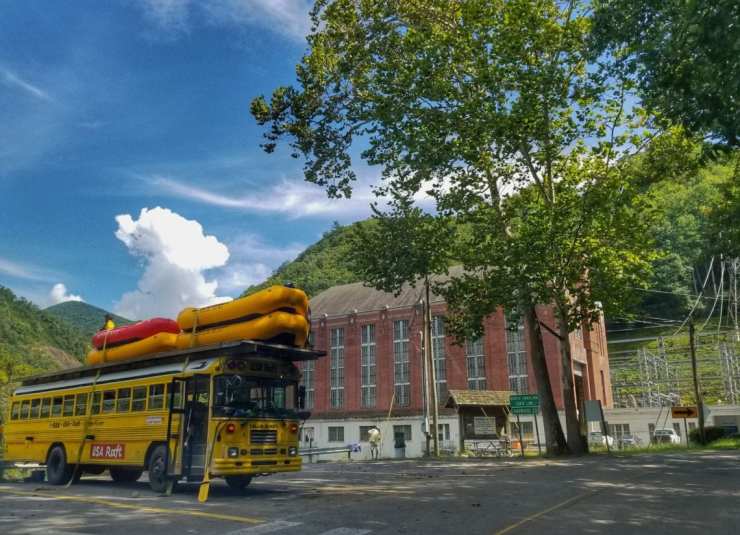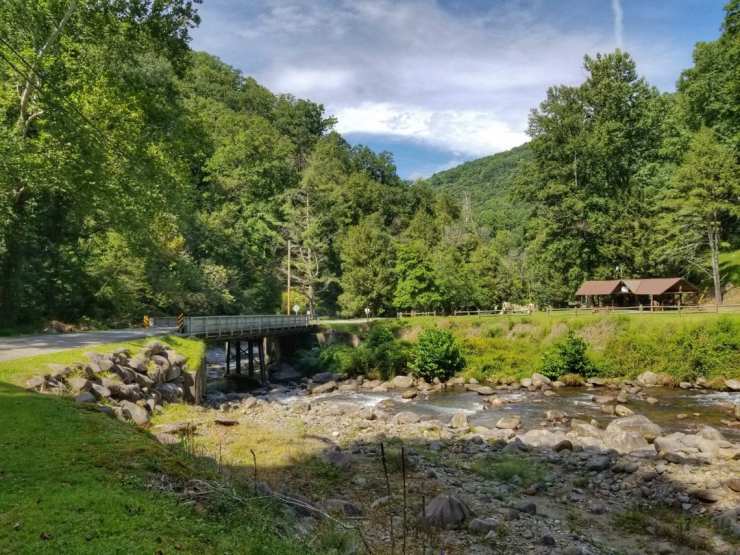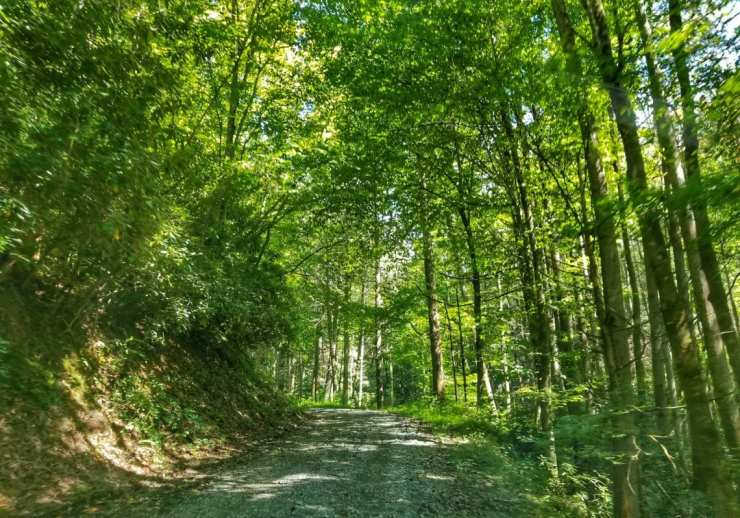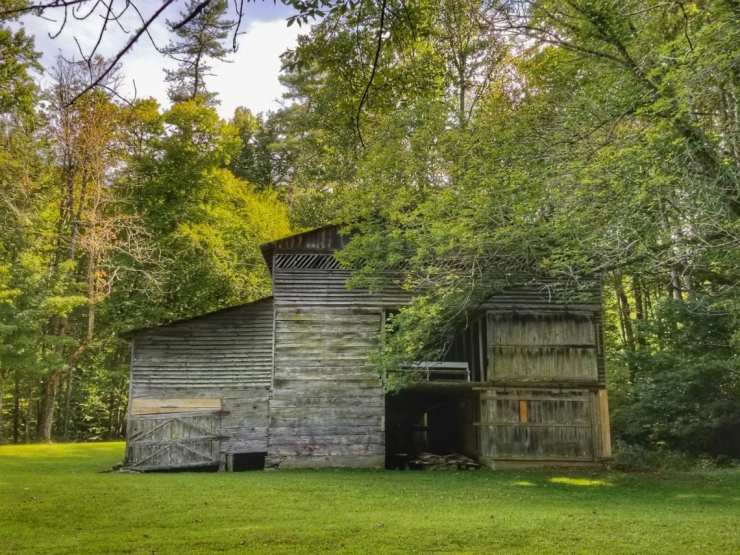It is the beginning of autumn here on the East Coast. I can feel it in the softness of the sunshine and in the nippy breeze that flows in and out of our home; ’tis in the hint of colour as the leaves on some trees in the park have started to flame out into brilliant reds, others have graduated to lime green, the rest are plain ol’ slowpokes holding onto their sheaths of green; I can feel the change in the simple pleasure of walking a couple of miles to the library, which might not be too a distressing figure at all, but smack in the middle of summer and winter, oh it feels far far away; there’s also the leonine golden retriever who sits with his old master everyday in the park and seems to have turned a deeper russet to welcome the season. Maybe it’s just my fancy, but he looks as happy as I feel. Now how the scenes would change if we were on the high ridges of the Great Smoky Mountains, where the woods are dense and human footfall rare, where it is the rutting season for the elks.
As warmer colours seep into the foliage around them, primal instincts (and love?) take over the workings of the animal kingdom in the valley called Cataloochee, where even as I write, the bull elks must find themselves bugling to the cows.
Cades Cove despite its lush beauty and picturesque meadows started to feel like a tourist’s thoroughfare when we hit the dirt roads that winded higher and higher up through Cataloochee that scooches within two main valleys, Big Cataloochee and Little Cataloochee, soldiered by 6,000 foot high ridges. We found a place of gravel roads, switchbacks and old steel girder bridges which together stitched up divides, ridges and narrow valleys.
All in all, it was a cathedral of silence around us. Not a single soul to be met as we passed by water power stations and old country stores, brooks and mountain cemeteries.
We were in ‘Gadalutsi’ of the Cherokees. They hunted and fished here just as they did in Cades Cove. The fertile land around the creeks here attracted the attention of European settlers who trickled in during the mid-1800s and bought the land from the tribes. They started calling it Cataloochee, possibly their stuttering take on the Cherokee name which referred to the straight-backed conifers lining the ridges. It is said to have been an amicable arrangement. The settlers mastered the Cherokee tongue and they co-existed peacefully with the tribes. Some even helped out those Cherokees who did not set out on the infamous Trail of Tears (in 1838 the tribes were forced to move across 1,200 miles on foot to present-day Oklahoma).
It seems fitting then that the descendants of those Cherokees, who clung to their land, should live on a reservation nearby today. At the Oconaluftee Indian Village they showcase their old ways of living to gaping tourists. We caught a whiff of it when we saw a wizened man there jump around in a towering headdress upon his head, a war bonnet. I have no doubt that his audience watched him with rapt attention.
But let me not veer from the Cataloochee which in the late 1800s to early 1900s had a community of just above a thousand people. It was the most lived-in place in the Smoky Mountains. Those pioneers grew corn for a living, set up grist mills, reared cattle for beef, sent their children to two-room schools, crafted shoes out of felt hats, sang of faith and participated in revivals with the arrival of autumn, brewed some ‘wicked’ moonshine, and generally, they lived the rustic life. When tourists discovered the beauty of these mountains and came knocking on their doors, these families boarded and charged them to fish trout in the creeks adjoining their land.
We found abandoned log houses in the valley, their rooms forlorn and empty of everything except for the fireplaces of bricks, bits and pieces of newspapers still sticking scrappily to the walls and reminding us that this was the humble life where people used paper for insulation. You could easily set up home within because you could see that the wood was sturdy.
Yet these people had abandoned their perfect little homes.
It turns out that they were asked to vacate their lands by the authorities when the Great Depression set in in the ’30s. For years, lumber companies had indiscriminately destroyed batches of old forestation with their dastardly business of logging. The mountains were in a bad way. Naturalists like Horace Kephart campaigned for the preservation of this beautiful part of the world, paving the way for the creation of the Great Smoky Mountains National Park, which also translated into jobs for young men. It was by 1934 when President Franklin D. Roosevelt granted it national park status that a whole mountain community had also lost their homes.
That is how we left it behind, the land which seems to exist on another dimension, as if no one had ever set foot within it except for the legacy of those early settlers which tell a different story. The voice in the video with its Transatlantic accent states succinctly: “National Parks are not built. God made them in the beginning.” But the preservation of this national park would not have got anywhere, it seems to me, without the sacrifice of these Cataloochee folks who could not have found it easy to let go of their beloved mountains.
P.S.: As usual there was no elk sighting in store for us. Not even a bear, and bears love showing up in the valley, they say. Just a fresh pile of bear doo-doo for us.




















Enjoyed reading the history of the Cataloochee Valley. Now, that’s a tongue twister! Yes, many have been displaced due to interstate roads, National Parks, and dams being built for the greater good but it’s always important to remember who it was that had given up so much in order for us to benefit in our present time. Thanks for reminding us of that. BTW, the bear definitely wanted to leave his mark on the place 😛
LikeLike
It is a tongue twister, I hear you. I uttered it over and over again because I could not help taking a fancy to it. These Native American names have more of a punch than regular English names.
Thank you for the kind words. And hey, we take what we get. Even if it be just bear scat. SIGH
SIGH
LikeLike
Lol!
LikeLike
I love how you write up your travels! Makes me want to race out and buy a ticket so I can go experience this!
LikeLike
Hey AJ, you are so lovely to indulge my rambles. You know, I think my words do not do half the justice that these places demand. They make you want to write poetry. Now only I if was any good at that. 🙂 xx
LikeLike
Oh I think you paint a good picture with your words already:)
LikeLike
You are too kind, lovely! xx
LikeLike
When I read these utterly charming pieces, I always feel as if I’m on the trip too.
LikeLike
It is always my pleasure to have you on a trip, Sheree. Thank you 🙂 xx
LikeLike
Wow, great history Arundhait. The valley is so green and very picturesque. Xx
LikeLike
Hi Lorelle, thanks for the comment as always 🙂 I wish words could communicate the beauty of the valley. xx
LikeLike
Sometimes our images just don’t replicate the true beauty we see through our own eyes ❤️
LikeLike
Hear hear! xx
LikeLike
Wow! This was so beautifully written and also educational. Thank you so much for highlighting the history of the land and how the national park came to be. My ancestors harvested crops on that very land. Again thank you so much for sharing this captivating, informative piece!
LikeLike
Hiya Victoria, thank you for dropping by and leaving a comment. Did your ancestors live in the Cataloochee Valley then? Were they of the families I found out about such as the Colwells, the Palmers, the Messers, …. I would be eager to know more of course! You know how a place makes you curious about its people. 🙂
LikeLike
Hi there my friend! My fathers side of the family are of Cherokee and European ancestry and did live in the valley though I’m not sure for how long or many details. This side of my families history is relatively new to me as I have just reconnected with them over the last 7 years, learning about our lineage, culture, and listening to their stories. I am interested to ask my Aunt more about our relation here and if/how we may be connected to the families you mentioned in your article. I have never been to see it for myself but through your words I felt the same sense I do when my family speaks of it.
LikeLike
It must be rather fantastic to get a sense of your ancestry. I guess as we grow older we learn the importance of knowing where you come from. I am reading Horace Kephart’s ‘Our Southern Highlanders’ and he writes so vividly that scenes from the book play out in the imagination every time I pick it up from where I left off.
LikeLike
I absolutely love the earliest days of fall. There’s just something in the air. Sort of an earthiness, for lack of a better word. This was an enjoyable read, Dippy, with some very pretty pics. From your narratives to the reliably solid research you put into your work, I always welcome a new post from you.
LikeLike
Thank you for the generous comment. You got me. I love my research alright. Comes from my days of reporting, I suppose. And hey, the admiration is mutual. Have a great Sunday! 🙂
LikeLike
Nice read Dippy , great place indeed .the homes of the early settlers , barn etc is fascinating !
LikeLike
Thank you Nisha 🙂 Hope your Sunday is going well. xx
LikeLike
Sunday was good Dippy enjoying last few humid days before the fall and winter !
LikeLike
Well imagine the joy they will bring. We are having a wet spell here
LikeLike
Yes right I’m ready for the change now ! Enjoy the rains ..
LikeLike
Interesting read ! The valley looks stunning, liked all the photos esp. the one with a caption Bridges & brooks, it looks like a heaven !!
LikeLike
Thank you, lovely! It was a piece of paradise. Hope you are having a nice Sunday. xx
LikeLike